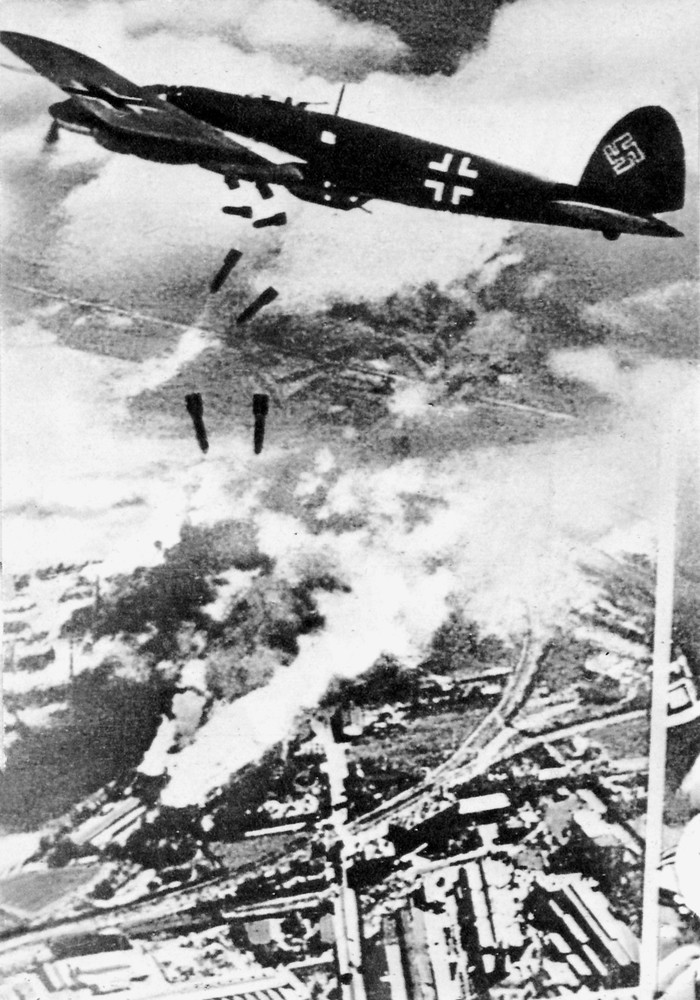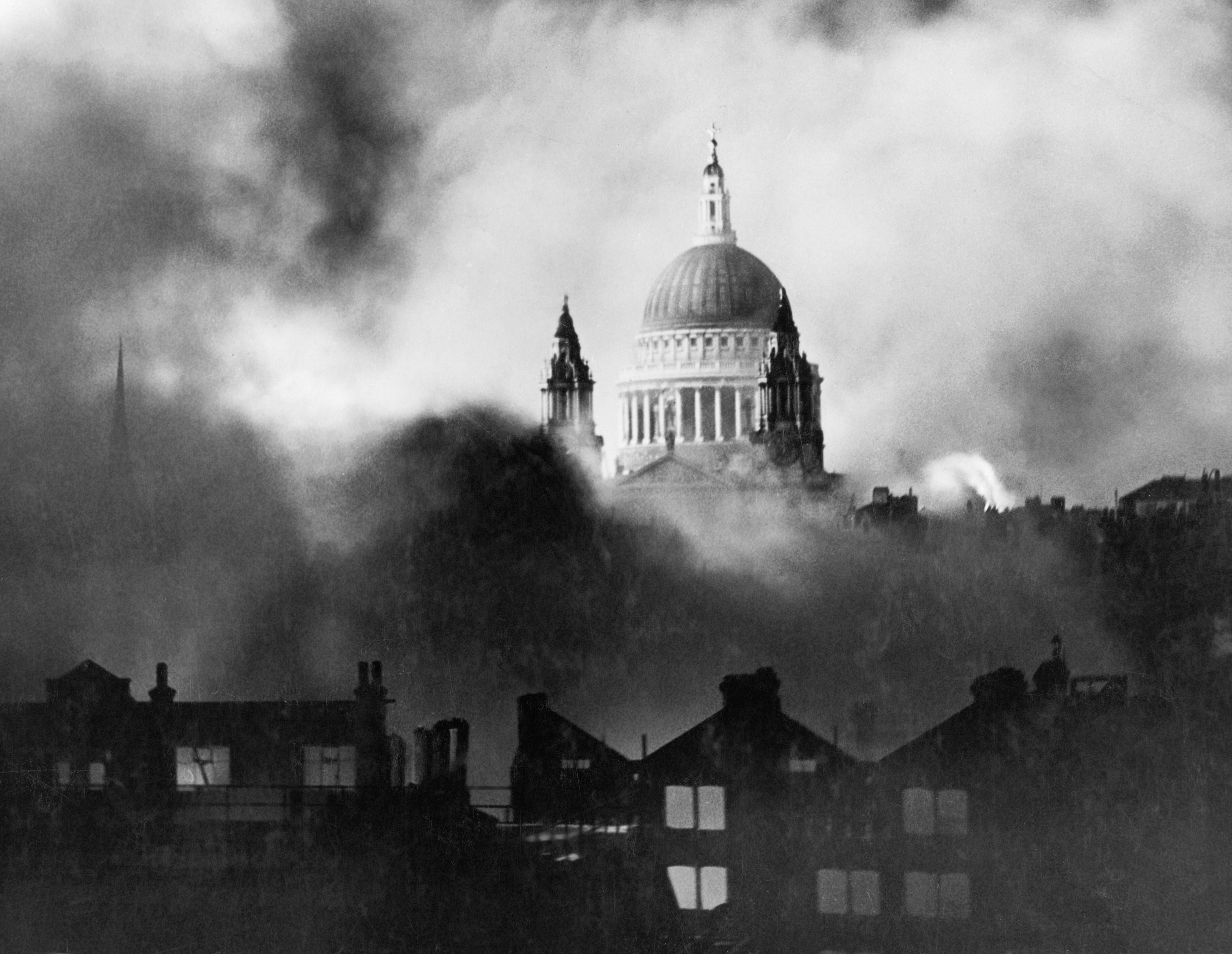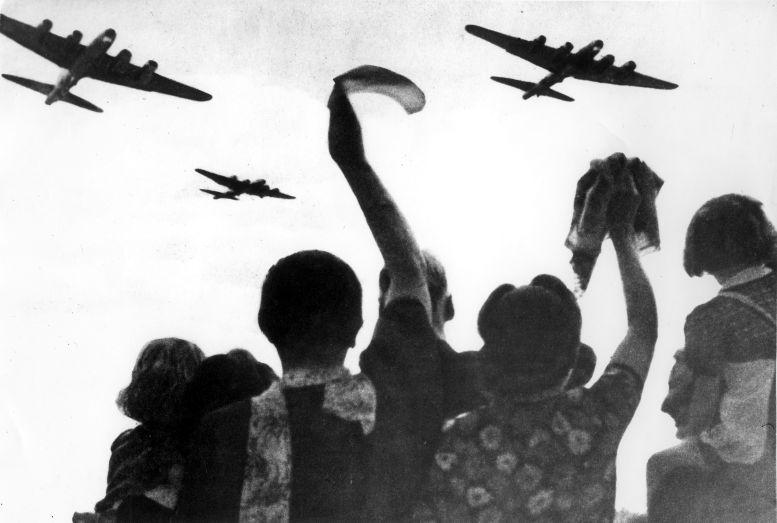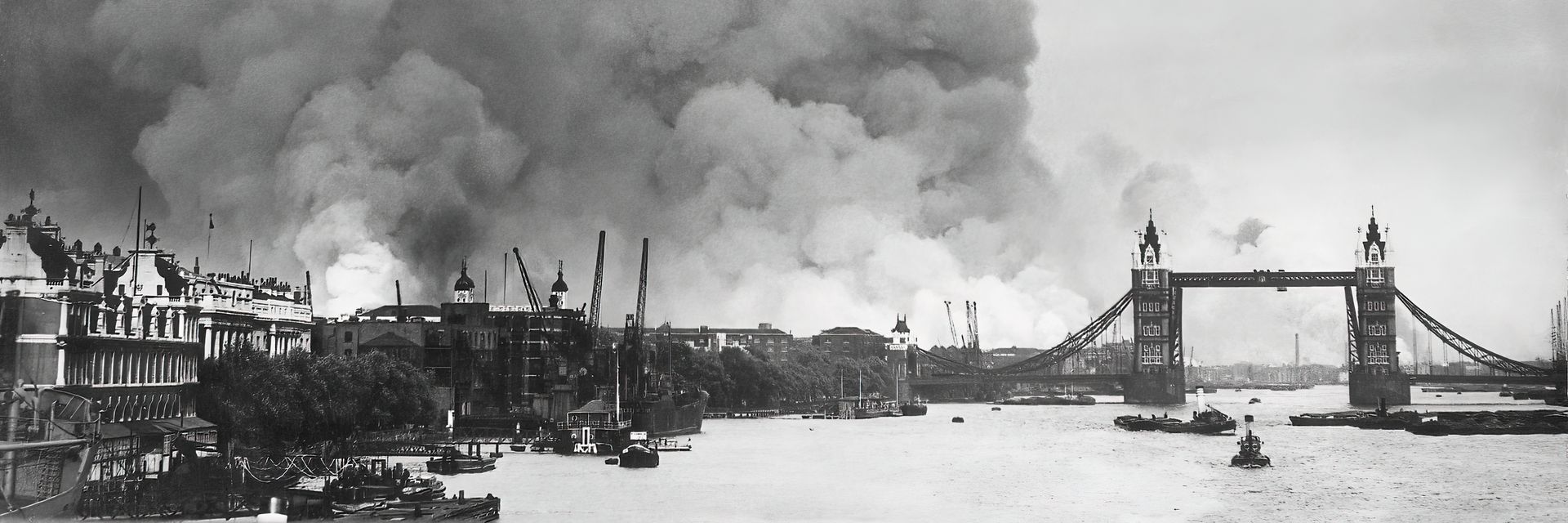Introduced by the Germans in World War II, blitzkrieg is a military tactic that focuses on a single, coordinated, and intense blow against an enemy. This new and brutal breed of warfare has been used by other nations to greater or lesser effect ever since.
◊
If at first you don’t succeed, try, try again.
This might have been the mantra guiding German military strategists between the throes of World Wars I and II. Following the signing of the Treaty of Versailles in 1918, Germany reflected on its losses and sought to improve strategically in the future. Success moving forward meant prioritizing offense rather than wasting away like sitting ducks in the trenches. Germany wanted to redeem its reputation and rectify its strategy going into WWII. The implementation of blitzkrieg warfare during WWII changed how the world would experience war moving forward.

German Heinkel He 111 aircraft bombing Warsaw, Poland, in 1939. (Wikimedia Commons)
Blitzkrieg Definition
Blitzkrieg (pronounced ‘blit-skreeg’): A military tactic characterized by sudden, concentrated attacks using armored tanks, boots on the ground, and air raids to overwhelm an enemy from all angles.
The German word blitzkrieg translates to “lightning war,” sparking connotations of the unforgiving power of nature at the height of a storm. Blitzkrieg relied on a full-frontal attack, ensnaring the enemy in a haze of artillery from every direction. Based on the Concentration Principle credited to the Prussian military strategist Carl von Clausewitz, blitzkrieg attacks mobilize as many resources as possible to attack a single target. The goal is to capitalize on the element of surprise while using speed to obliterate the enemy. Using this tactic, Germany secured victory after victory while suffering fewer casualties among its troops than in traditional warfare. But blitzkriegs were launched against cities and other hubs of social activity, and the Germans had little concern for civilian victims of the attacks.
For more on the Luftwaffe and other Nazi war tech, check out the MagellanTV series Nazi War Machines.
German Blitzkrieg Tactics in World War II

St. Paul’s Cathedral in London during a fire raid. (National Archives Catalog)
WWI was fought with defense at the forefront of each military’s strategy. Trench warfare allowed armies ample time to establish their defensive fronts, yet the tactical disadvantage of constructing trenches and the unsanitary conditions they produced left troops buried half alive. The landscape of the battlefield changed with every advance, and the cascade of artillery left the earth in ashes with bodies littered on top. When the world erupted in turmoil once again in 1939, Germany was eager to rectify its military strategy and curtail the casualties this time around. At 4:45 a.m. on September 1, 1939, the first of many blitzkriegs rained down on Poland. Hitler’s invasion of Poland took the nation by surprise as 2,000 tanks, 900 bombers and 400 fighter planes began to attack. The German Nazis emerged from sea, sky, and land, ready to wage war on all fronts.
Battles Where German Blitzkrieg Was Successfully Used
Germany used blitzkrieg to kick off WWII with the invasion of Poland. In the following years, Germany invaded Norway, Belgium, France, and the Netherlands employing the same tactic of surprise. When Germany intervened to aid the Italian invasion of North Africa, the unexpected brutality of the attacks pressured British and French troops into a position of constant defense. Perhaps the most notorious use of blitzkrieg was in the sustained bombing campaign known as ‘the Blitz’ that targeted British cities and towns. Attacks of this nature drew everyday people onto the frontlines of the war. WWII was a total war, calling on all aspects of society to take part in the war effort. No industry, no company, no nation, and no person could evade the reach of the blitzkrieg.
Starting on September 7, 1940, London was bombed for 57 straight nights, forcing tens of thousands of people to seek shelter in the London Underground System. The London Passenger Transport Board served ‘twopenny meals’ along with tea and coffee to those who brought their own mugs.
Why Was the German Blitzkrieg So Effective?

A Soviet soldier during the invasion of Poland, 1939.
(Imperial War Museum, Second World War Press Agency Print Collection / Wikimedia Commons)
The ‘Lightning War’ technique restored the reputation of the Wehrmacht, the defense forces for the Third Reich. Through its brazen invasions, German military forces came back with a vengeance after their defeat in WWI. Blitzkrieg relied on surprise, speed, and ground coverage, making use of each military branch within the Wehrmacht. By calling on seamen and soldiers alike, Germany freed up enough resources to ensure that any resistance could be squashed.
Blitzkriegs followed a formulaic approach: attack, penetrate, and encircle. With time on their side, the Germans swarmed like bees to a hive, deploying bombs and storming city streets. War descended on Europe, and with Germany’s revitalized strategy, early battles tended to end in their favor. The surprising and unexpected nature of the blitzkrieg left countries defenseless as their forces tried to rally in the middle of the night.
Germany was First to Use Blitzkrieg in World War II

Map of Poland in 1939. (Department of History, United States Military Academy / Wikimedia Commons)
While elements of blitzkrieg had been used prior to the twentieth century, the advent of new technologies in aircraft, weaponry, and communication made the term blitzkrieg synonymous with WWII. Germany was the first nation to adopt this militaristic practice and used its novelty to gain a psychological edge over the Allied forces. Blitzkrieg strategies would be borrowed by the Allies after a few years, but in the early days of the war, Germany secured a tactical lead as its enemies scrambled to defend against it.
Combined Land & Air Forces
Though primarily focused on the strategic allocation of their own resources before attacking, blitzkrieg campaigns aimed to target the weakest point in the enemy’s defense. The Wehrmacht was broken up into the Heer (army), the Luftwaffe (air forces), and the Kriegsmarine (navy). The blitzkrieg strategy relied on all three of these branches to support one another while attacking in unexpected ways. Once the Nazis had identified a city or border that could be easily breached, the Wehrmacht would send armored tanks, mobile infantrymen, and air bombardments to enshroud the enemy in a haze of smoke before charging ahead for the final blow.
Utilized Radio Communications to Coordinate Attacks
In addition to the advances in airplanes and weapons, WWII saw the first use of portable radios by battalions. The immediacy of radio communication meant that those in the sky could provide information about a battle with a bird’s eye view. Troops miles away from one another could coordinate attacks and synchronize their land and air forces. The Germans were the first to use these advanced radio systems in WWII, but their widespread use by all powers in the war soon meant that communications needed to be done in code.
Why Did the German Blitzkrieg Fail?

Allied planes over Holland. (The Spaarnestad Collection / Wikimedia Commons)
The initial advantage held by the Germans set them up well in WWII, but as the war raged on, the Allies began borrowing blitzkrieg tactics. Europe had been ablaze too long – it was time to fight fire with fire. General George Patton had been a keen student of German literature in his youth, but when he joined the United States military, he applied his interest in Germany to breaking down its actions in war. Patton encouraged a blitzkrieg mentality among the troops he led, emphasizing “short, sharp, and furious” campaigns. He commanded Allied forces to stay mobile rather than restricting themselves as had happened in the trenches. By the time Axis troops ventured into the Soviet Union in 1941, the Allies had a better idea of what to expect and the Nazis suffered more casualties than anticipated. The novelty of surprise faded after the overuse of blitzkrieg. For the rest of the war, the Axis and Allied powers alike suffered the burn of the Blitz.
“A good plan violently executed now is better than a perfect plan executed next week.” —General George S. Patton
Other Uses of Blitzkrieg & Its Impact on Today
Blitzkriegs were firecrackers that appealed to militaries for their fleeting glow and intoxicating power. They blatantly violated the conventions of war that had been multilaterally agreed upon at the Hague Conventions (1899, 1907) and at the first Geneva Convention (1929). While tactically advantageous to military operations, blitzkriegs disregarded the procedure for declaring war, condoned the blind slaughtering of civilians, and fed the idea that unethical attacks were worthwhile if they secured a big enough advantage. As more countries adopted blitzkrieg techniques in WWII, their efficacy wore down in tandem with Germany’s lead.
The Iraq War
The United States’ invasion of Iraq in 2003 saw the advent of a modernized blitzkrieg campaign. The term ‘shock and awe’ flooded American news coverage and set expectations for a quick victory in Baghdad. Harlan Ullman, who coined the term ‘shock and awe campaign,’ noted that this was misportrayed in the media as a mirror of blitzkrieg tactics. He claims the campaign’s intended objective was not to target civilian centers or kill people, but rather to destroy an enemy’s sense of unity, purpose, and will to fight.
The invasion of Iraq was, in important respects, guided by the so-called ‘Powell Doctrine,’ a term created by journalists. Gen. Colin Powell, who served as chairman of the Joint Chiefs of Staff during Operation Desert Storm in 1991 and Secretary of State during President George W. Bush’s first term, advocated the vigorous use of diplomacy before the application of overwhelming military force to resolve conflicts. Military operations, when deemed necessary, were to be swift, strategic, and successful. The initial attack on Iraq in 2003 borrowed some psychological elements of blitzkrieg by emphasizing the ‘shock and awe’ tactic that had been used in Operation Desert Storm, but it starkly differed from the WWII German model in its efforts to minimize collateral damage (i.e., deaths of noncombatants and destruction of civilian infrastructure).
Russia’s 2022 Invasion of Ukraine
Russia’s ongoing invasion of Ukraine is a striking example of the unethical, inhumane consequences of a blitzkrieg attack (albeit a militarily unsuccessful one, so far). After the former Soviet Union’s annexation of the Crimean Peninsula in 2014, Russia-supported forces have engaged in armed conflict with Ukrainian soldiers over ownership of the Donbas region. Following years of ignored ceasefires and constant cyber-attacks, Russia launched a full-scale invasion into Ukraine on February 24, 2022.
What Russia continues to call a ‘special military operation’ has resulted in the deaths of more than 3,000 civilians and the displacement of seven million people. As is common in blitzkrieg attacks, the assailant, Russia, did not formally declare war and to this day has refused to do so. Russian missiles launch into schools, shopping malls, hospitals, and homes on a daily basis, tormenting the Ukrainian people from afar before the conflict arrives on their doorstep. The city streets of Mariupol, Donetsk, and Luhansk have become battlefields as Ukrainian civilian soldiers defend their homes from Russian forces on the ground. The televised reports and real-time streaming of the atrocities in Ukraine have brought the reality of a modern-day blitzkrieg to our eyes, making it both hard to watch and tragically easy to look away.
Want to Learn More About German War Machines?
While blitzkrieg had been introduced with the intent to lessen the bloodshed for German offenses, its application between 1939 and 1945 made WWII the deadliest war in human history. On paper, blitzkrieg was a simple yet genius strategy. In reality, blitzkriegs manipulated the emotions of an enemy relying on fear, surprise, and disorganization to cause mass casualties among civilians and soldiers alike. What first took the Allied powers by surprise supplied them with the strategy that would ultimately secure their win. The Allies studied the enemy’s strategy to use it against them, and nations have followed suit ever since. For a glimpse into the other tools that fanned the flames of WWII, watch Nazi War Machines on MagellanTV.
Ω
Daisy Dow is a contributing writer for MagellanTV. Her articles also appear in Local Life magazine. She recently graduated from Kenyon College with a degree in philosophy and studio art.
Title image: London during the Blitz of WWII. (Source: Public domain, from the holdings of the National Archives and Records Administration, via Wikimedia)

